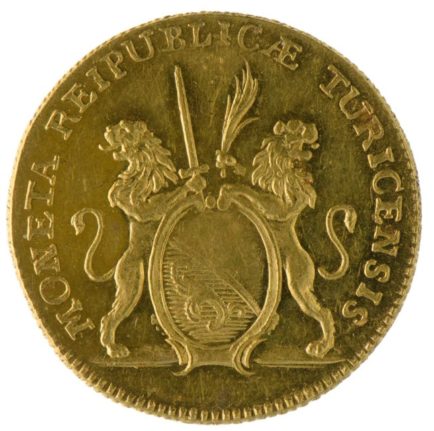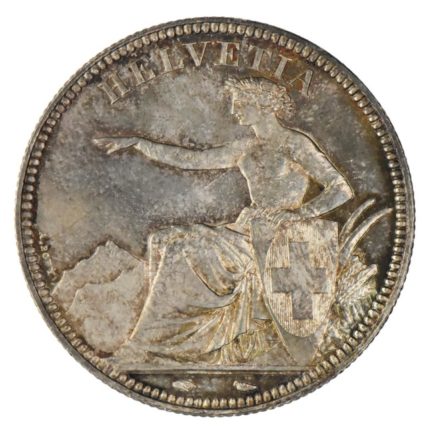How Switzerland chose the franc as its currency

We carry it in our wallets and use it every day to purchase all kinds of goods and services. But have you ever wondered how the franc became Switzerland’s currency?
To answer this question we have to go back to 1849 - the year before was a decisive turning point in the country’s history.
September 12th, 1848 marked the creation of the Swiss federal state and its new Constitution, and Bern became the seat of the government the same year.
READ MORE: Why is Bern the ‘capital’ of Switzerland?
But while many political matters were put in order, some issues still needed to be settled.
For instance, there was much chaos surrounding Switzerland’s regionally-based currencies.
In an article titled “The difficult birth of the Swiss Franc”, Swiss National Museum writes: “If you were travelling through the young federal state in 1849, you had to either have at least ten money purses, or be constantly running to the change money. In Zurich people paid with ducats or thalers, in Schwyz they wanted centimes, and in Chur the bill for your dinner was in batzen”.

Two Zurich ducats. Image: Swiss National Museum
Such a disparate monetary system was not sustainable so a single currency had to be introduced. However, the debate over what system this unified currency should be based on fuelled disputes and sparked controversy.
“It was necessary to choose between the decimal system of the French franc and that of the guilders of southern Germany. This question divided our country: French-speaking Switzerland, Bern and Basel wanted the franc, eastern Switzerland and Zurich wanted the guilder” the article says.
The government commissioned a prominent banker and politician Johann Jakob Speiser to carry out an assessment. He concluded that Swiss monetary system should be based on France’s, as franc would improve Switzerland’s access to the global economy.
The supporters of the guilder, however, didn’t agree and they started to collect signatures on petitions against the French system.
“But all the pleading, begging, cajoling, ranting and cursing was of no use”, the museum article states.
The parliament introduced the franc and the corresponding federal law on the national currency was enacted in May 1850.
But then “new trouble loomed”: the sitting Helvetia figure created by the Geneva engraver Antoine Bovy angered many politicians. They claimed the figure was too ugly and “unlike the archetypes from antiquity, she wasn’t holding anything in her hand”.

Sitting Helvetia didn't win over fans. Image: Swiss National Museum
This stance was summed up by the Neue Zuger Zeitung, which wrote that Helvetia “was reaching into every cash register, bag, purse and savings bank and challenging the old money that people had been used to for 100 years”.
The National Council also suggested the “Helvetia that everyone loathes” be removed from the new coins.
But the woman symbolising Switzerland remained in sitting position until 1875. She has been standing ever since.
The decision not to adopt the guilder system turned out to be a good one, the article noted. By the end of 1871, the German Empire adopted the mark as its single currency, and the guilder, thaler and ducat slowly disappeared from circulation.
READ MORE: Why does Switzerland use ‘CH’ and what does it mean?
Comments (1)
See Also
To answer this question we have to go back to 1849 - the year before was a decisive turning point in the country’s history.
September 12th, 1848 marked the creation of the Swiss federal state and its new Constitution, and Bern became the seat of the government the same year.
READ MORE: Why is Bern the ‘capital’ of Switzerland?
But while many political matters were put in order, some issues still needed to be settled.
For instance, there was much chaos surrounding Switzerland’s regionally-based currencies.
In an article titled “The difficult birth of the Swiss Franc”, Swiss National Museum writes: “If you were travelling through the young federal state in 1849, you had to either have at least ten money purses, or be constantly running to the change money. In Zurich people paid with ducats or thalers, in Schwyz they wanted centimes, and in Chur the bill for your dinner was in batzen”.

Two Zurich ducats. Image: Swiss National Museum
Such a disparate monetary system was not sustainable so a single currency had to be introduced. However, the debate over what system this unified currency should be based on fuelled disputes and sparked controversy.
“It was necessary to choose between the decimal system of the French franc and that of the guilders of southern Germany. This question divided our country: French-speaking Switzerland, Bern and Basel wanted the franc, eastern Switzerland and Zurich wanted the guilder” the article says.
The government commissioned a prominent banker and politician Johann Jakob Speiser to carry out an assessment. He concluded that Swiss monetary system should be based on France’s, as franc would improve Switzerland’s access to the global economy.
The supporters of the guilder, however, didn’t agree and they started to collect signatures on petitions against the French system.
“But all the pleading, begging, cajoling, ranting and cursing was of no use”, the museum article states.
The parliament introduced the franc and the corresponding federal law on the national currency was enacted in May 1850.
But then “new trouble loomed”: the sitting Helvetia figure created by the Geneva engraver Antoine Bovy angered many politicians. They claimed the figure was too ugly and “unlike the archetypes from antiquity, she wasn’t holding anything in her hand”.

Sitting Helvetia didn't win over fans. Image: Swiss National Museum
This stance was summed up by the Neue Zuger Zeitung, which wrote that Helvetia “was reaching into every cash register, bag, purse and savings bank and challenging the old money that people had been used to for 100 years”.
The National Council also suggested the “Helvetia that everyone loathes” be removed from the new coins.
But the woman symbolising Switzerland remained in sitting position until 1875. She has been standing ever since.
The decision not to adopt the guilder system turned out to be a good one, the article noted. By the end of 1871, the German Empire adopted the mark as its single currency, and the guilder, thaler and ducat slowly disappeared from circulation.
READ MORE: Why does Switzerland use ‘CH’ and what does it mean?
Join the conversation in our comments section below. Share your own views and experience and if you have a question or suggestion for our journalists then email us at [email protected].
Please keep comments civil, constructive and on topic – and make sure to read our terms of use before getting involved.
Please log in here to leave a comment.